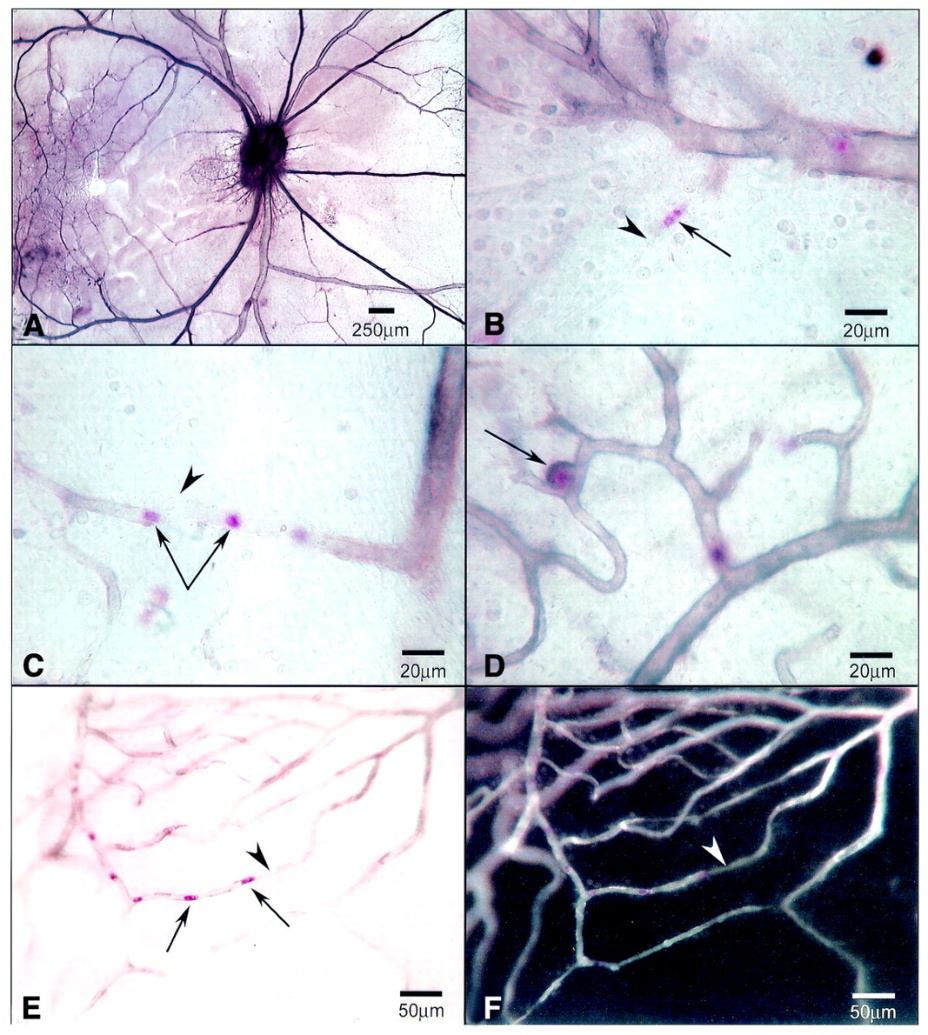Abstract
Type 2 diabetes develops spontaneously in obese aging rhesus monkeys (Macaca mulatta). This study investigates the association between polymorphonuclear leukocytes and development of retinopathy. Blood pressure and plasma glucose levels were determined in 15 diabetic and 6 nondiabetic monkeys. The plasma levels of total cholesterol, LDL cholesterol, HDL cholesterol, and triglycerides were determined just before the start of the animal’s final decline and elective necropsy. Retinas were incubated for ADPase (labels viable retinal blood vessels) and nonspecific esterase (labels neutrophils) activities. Polymorphonuclear leukocytes were counted per millimeter squared of retina. After the retina was flat-embedded in glycol methacrylate, tissue sections were taken through areas of interest and observed microscopically. Elevated numbers of intravascular polymorphonuclear leukocytes were present adjacent to areas with retinal capillary nonperfusion. There were significantly more polymorphonuclear leukocytes per millimeter squared in diabetic retinas (6.91 ± 5.01) compared with normal retinas (1.45 ± 1.62, P = 0.018). Severity of hypertension in diabetes was also significantly associated with greater numbers of polymorphonuclear leukocytes (P = 0.02). There was a significant positive exponential correlation between the number of polymorphonuclear leukocytes per millimeter squared and the level of total cholesterol (R = 0.907), LDL cholesterol (R = 0.875), the total cholesterol–to–HDL cholesterol ratio (R = 0.86), and total triglycerides (R = 0.888). This study demonstrates that severity of diabetes and the development of retinopathy are associated with increased numbers of polymorphonuclear leukocytes in the retina of diabetic monkeys. Hypertension, high plasma levels of LDL cholesterol and triglycerides, and low plasma levels of HDL cholesterol also are associated with increased polymorphonuclear leukocytes in retina.
Keywords: DD, disc diameterICAM-1, intracellular adhesion molecule-1ROS, reactive oxygen species

Fig. 2. Nonspecific esterase and ADPase labeling in a 31.5-year-old diabetic monkey (no. 14) (A–D) and a 31.2-year-old diabetic monkey (no. 13) (E and F). A: A large area of capillary loss extends from fovea to optic disk within and beyond the vascular arcades as well as a large area nasal to optic disk. An apparent cilio-retinal vascular system temporal to the disc remains viable (i.e., has ADPase activity). B: Red nonspecific esterase–positive neutrophils (arrow) are present in a vascular segment that lacks ADPase activity (arrowhead). C: Two neutrophils (arrows) are present on either end of a vascular segment that lacks ADPase activity. There is a branch of the capillary (arrowhead) that also lacks ADPase activity. D: A neutrophil is present in an aneurysm that has formed at a branch point in a capillary. E: Brightfield illumination shows neutrophils (arrows) in a capillary segment adjacent to a nonperfused area (arrowhead). F: Darkfield illumination of the same area in E shows reduction in ADPase activity in some of the capillaries in this area of capillary dropout. A–E: Bright field illumination of flat mount retina. F: Darkfield illumination of flat mount retina.
Tel : 028-8592-1823 (in China)
Tel:+1-517-388-6508 (in US)
Tel : +86 (28) 8592-1823 (outside of China)
Fax : +86-28-62491302
Zip code : 610041
Address: No.88, Keyuan South Road, Hi-tech Zone, Chengdu, Sichuan Province, China